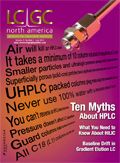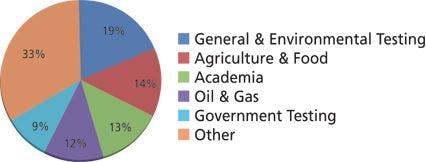Peaks of Interest
Peter Carr and Davy Guillarme, the 2013 winners of the LCGC Lifetime Achievement and Emerging Leader in Chromatography Awards, respectively, will be honored this fall at the SciX 2013 conference.
LCGC Awards Winners Peter Carr and Davy Guillarme to Be Honored at SciX
Peter Carr and Davy Guillarme, the 2013 winners of the LCGC Lifetime Achievement and Emerging Leader in Chromatography Awards, respectively, will be honored this fall at the SciX 2013 conference. The conference, organized by the Federation of Analytical Chemistry and Spectroscopy Societies (FACSS), will take place September 29–October 4 at the Hyatt Regency Milwaukee and Delta Center in Milwaukee, Wisconsin.
Carr, a professor in the department of chemistry at the University of Minnesota (Minneapolis, Minnesota), won the 2013 LCGC Lifetime Achievement in Chromatography Award. He is scheduled to give a plenary talk on Thursday, October 4, titled "Two Dimensional Liquid Chromatography. The Future of HPLC?" Later that morning, he will be honored in an award symposium. Other scheduled speakers in that symposium are Todd D. Maloney of Eli Lilly and Company (Indianapolis, Indiana) whose talk is titled "Development and Application of Two Dimensional HPLC for Small Molecule Pharmaceutical Analysis," Dwight Stoll of Gustavus Adolphus College (Saint Peter, Minnesota), who will address "Characterization of Carbon Nanomaterial Modified Silicas for Use in Two-Dimensional High Performance Liquid Chromatography," and David Sherlock of PPD (Middleton, Wisconsin) speaking on the topic "Use of Two-Dimensional HPLC in a Contract Lab Environment for MS Analysis of Unknown Analytes in Mobile Phases Containing Non-Volatile Modifiers."
Guillarme, a Maître Assistant of the School of Pharmaceutical Sciences at the University of Geneva, University of Lausanne (Switzerland), is the winner of the LCGC Emerging Leader in Chromatography Award. The symposium on Wednesday afternoon, October 3, honoring Guillarme will focus on fast liquid chromatography (LC). In that session, Guillarme will give a talk titled "Innovative Strategies for the Analysis of Pharmaceutical Compounds." Also speaking at this session will be Gert Desmet of Vrije Universiteit Brussels (Brussels, Belgium), whose talk is titled "A Novel Optimization Strategy for Multi-Segment Gradient Method Development Based on the One-Segment-Per-Component Strategy," Jason Anspach, senior scientist at Phenomenex (Torrance, California), whose talk title is to be announced, and Archana Kumar, associate scientist at Genentech (San Francisco, California). Kumar will speak on "Genotoxic Impurities Analysis and Control Strategies in Pharmaceutical Development."
These plenary and award sessions will be part of a series of symposia at the conference focusing on chromatographic and electrophoresis separation methods. The SciX conference, formerly named "FACSS" after its organizing body, is in its 40th year and is well known as an important venue for scientific discussion related to spectroscopy. The event organizers are now placing a renewed focus on separation science in the program, and hope to draw a sizable audience of chromatographers, particularly from academia and the pharmaceutical and chemical industries in states near the Wisconsin venue, such as Minnesota, Illinois, Indiana, and Michigan.

Characterizing Plant Polysaccharides Using Size-Exclusion Chromatography
April 4th 2025With green chemistry becoming more standardized, Leena Pitkänen of Aalto University analyzed how useful size-exclusion chromatography (SEC) and asymmetric flow field-flow fractionation (AF4) could be in characterizing plant polysaccharides.
Investigating the Protective Effects of Frankincense Oil on Wound Healing with GC–MS
April 2nd 2025Frankincense essential oil is known for its anti-inflammatory, antioxidant, and therapeutic properties. A recent study investigated the protective effects of the oil in an excision wound model in rats, focusing on oxidative stress reduction, inflammatory cytokine modulation, and caspase-3 regulation; chemical composition of the oil was analyzed using gas chromatography–mass spectrometry (GC–MS).











